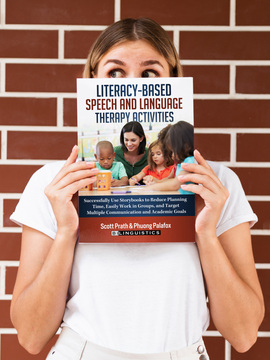I love using books in speech therapy, and I use them for all of my groups: language (of course!), articulation and fluency. You name the speech impairment, and I’ve got a book (or 10) for it. Twice a week, I see 4 kindergarteners for an articulation and fluency group. All of the students are working on their /k/ and /g/ sounds, and one student is working on fluency.
Use books in speech therapy to target many goals! Featured book: Caps for Sale by Esphyr Slobodkina
This week I used Caps for Sale, a tale of a multi-cap-wearing-peddler trying to sell caps. After a slow day, he takes a nap and runs into some mayhem with monkeys.
So, here is how I do it:
- Hand out counters to each student. I have already modeled appropriate use of the tool. They are stoked to be able to track their own progress. Remember, students need to be able to self-monitor their sound production prior to using this tool.
- Review goal(s) for the day. I do this through a “goal rap”. Each student knows his/her specific sound. “We work (clap, clap)! We work (clap, clap)! We work on our sounds!”
- Begin reading Caps for Sale.
- Each time I come to a word containing the /k/ or /g/ sound, I stop. “I found our sound! Now, let’s say it 20 times!” I differentiate this task for each student. Here’s what I have for my group:
-
- Student A & C: All positions at sentence level: “Say, ‘The man is selling caps!’”
- Student B: All positions at the word level: “Say, ‘Caps.’”
- Student D: Fluency: “Say, ‘The man is selling caps.’ Track what kind of a bump you just had.”
Here is a video of how Student A tracked his own production at the sentence level while reading books in speech therapy.
I document the words used in the book. Here are a few: caps, walk, monkey, carried, back, checked, gray and called. I also write down words that were challenging for each specific student.
By the end of the 30 minute session, students had approximately 100 repetitions of their target sound and opportunities to self-identify disfluencies.

I send a quick email to their teachers to let them know what we worked on. Do I do this after every session? No. However, reinforcement and generalization is important! I let them know about the books in speech therapy that we are practicing with, and also find out what books are being read in class and try to reinforce /k/ and /g/ words used in the classroom.
And that is how I used Caps for Sale in therapy. In this case, monkeying around, definitely has great speech benefits.

Literacy-Based Speech and Language Therapy Activities includes great ways to help your students develop story grammar components. And (there’s more!), check out our favorite books for speech therapy. You will discover some of our favorites for intervention. We love big books, and we cannot lie!





Do you mind sharing your 9 other books? I do a lot of the same activities, and I even have a whole lesson set up for “Cap for Sale”. I make individualized lists of words for each phoneme to target from each book. When my kids get to a mastery level then I can send home the printed word sheet for them to use as homework, or I can highlight certain words. If their parent initials it five times (for 5 practices) and then returns it to me they get a reward. I have found that a lot of words from everyday books carry many Dolch words and I am getting a lot targeted almost incidentally. I also work on language skills with story markers and ask questions based on Bloom’s taxonomy. This often becomes the questions I use for my fluency and voice kids (if I have any). Initially it takes a bit of time to get it all set up but I have about 20 or so books in my arsenal that I reuse, so once it’s done I’m set.
I love using new books and I’d love to hear what you use to add to my collection.
Tracey,
Thanks so much for taking the time to reach out to us. I loved and appreciated hearing your speech and language ideas. I whole-heartedly agree with you–investing time in the beginning saves much heartache and planning. I always tell my SLPs that our work, every year, should get easier. Our efforts should be cumulative. To be honest, I have used many, many books over the last decade and a half. Here is a link to a few books and therapy ideas for elementary age.
I typically like to use books that are 1) aligning to the children’s curriculum, 2) incorporating various cultures (including poverty) and 3) making some connection to the children’s experiental background. A few more of my favorites are The Name Jar, Those Shoes and Heckedy Peg (I just love Audrey Wood!). Here is a great list compiled by my alma mater, the University of Wisconsin.
I also want to recommend a few wordless pictures books. At times, pictures can evoke beautiful language from children. Mercer Mayer’s Frog series and Tuesday serve this purpose well. Great wordless picture books for children at the secondary level are The Arrival, Middle Passage and Zoom. Keep in mind that wordless picture books are great to use for families who may need literacy support.
Again, thanks for reaching out to us. Please keep in touch, and I would love to hear your list, as well!
Take care,
Phuong
Do you mind sharing your 9 other books? I do a lot of the same activities, and I even have a whole lesson set up for “Caps for Sale”. I make individualized lists of words for each phoneme to target from each book. When my kids get to a mastery level then I can send home the printed word sheet for them to use as homework, or I can highlight certain words. If their parent initials it five times (for 5 practices) and then returns it to me they get a reward. I have found that a lot of words from everyday books carry many Dolch words and I am getting a lot targeted almost incidentally. I also work on language skills with story markers and ask questions based on Bloom’s taxonomy. This often becomes the questions I use for my fluency and voice kids (if I have any). Initially it takes a bit of time to get it all set up but I have about 20 or so books in my arsenal that I reuse, so once it’s done I’m set.
I love using new books and I’d love to hear what you use to add to my collection.
It’s rare for me to have a group that’s all working on the same sounds.
Yes, having a group of students who are ALL working on the same sounds is a luxury only seen in CSD textbooks teaching what to do in articulation therapy. The beauty of using books for speech therapy is that we can identify the different sounds that match the goals for each student. For example, if you have three students working on /l/, /r/, and /s/. Photocopy a page from the book 3 times. Highlight /l/ on one page, /s/ on the next, etc. These sheets ARE your data. Circle or cross out the sounds/words as your student says them. Older children can see how they did and work to correct their errors while reading.
Hi, books are wonderful to use with children to help meet their speech and language therapy goals. I just wanted to suggest that the clicker activity with the fluency kid be used in the same positive manner that the articulation kids are using it. Identifying bumpy speech is good for awareness building and desensitization. However since the other children use the clicker for their good velar sounds, the fluency kid could click each time he tries to say his phrase using smooth speech/easy talk.
Stacey,
Good point! Having students track their own progress is great for 1) accountability, 2) self-assessment and 3) motivation. My student working on fluency did use the clicker to document his fluency. He helped me with data keeping, loved seeing his progress and had fun. Thanks so much for reading the blog and sharing your ideas. We would love to hear more!
Take care,
Phuong
I love this idea. I have so many books but find it difficult to keep kids engaged with them. I am constantly hearing, “Can we play a game?”. I am new to the school this year and am trying to break the “game” habit. It is difficult.
I am trying to look up those clickers on Amazon and am not having luck. What are they called so I can find them?
Hi Amy,
The clickers are also referred to as “counters”. Here is a link to purchase them on Amazon I appreciate your efforts to use literacy-based therapy. In my experience, once you start using books in a fun and engaging way, the students look forward to those activities. Here are some fun ways I have incorporated books:
1. Find (age-appropriate and grade-level) books with their interests. I had a group of 5th grade boys, and they all loved football. So, we used books about football. We tackled story grammar, compare/contrast skills, retell, and describing. I typically have the same theme/book for an entire month. At the end of the month, I always “seal the deal” with an event. In this case, the boys Skyped with an NFL football coach. It was awesome.
2. We act out the scenes from the book. When reading Audrey and Dan Wood’s King Bidgood’s in the Bathtub, all the kids had to find a way to fit into a pretend bathtub. While trying to squeeze into the bathtub, the kids were able to say approximately 100-200 repeitions of their words. Effective and fun!
3. If possible, I try to share the book with the student(s) class(es). I will have a narrative-based lesson with an entire class. We use story grammar raps and incorporate them into the class lesson. My speech students feel like the experts, I am showing the teacher the skills we use in speech (this supports generalization) and we are showing casing our skills as the “language experts”.
Good luck, Amy. Please let us know how it goes!
Phuong
phuong.palafox@bilinguistics.com
Thank you! I got the clickers and they are working well. I found a multi colored pack of 5 for only $10. Kids love them. Thanks for your great ideas!
Amy,
I am so glad it’s going well! And, what a deal!
Phuong